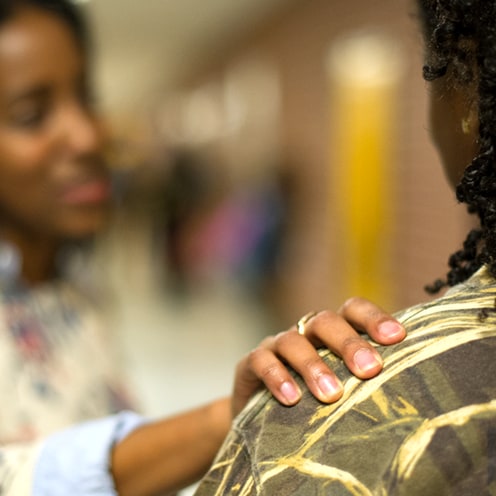
Teacher Burnout: Who It Affects, What Can Be Done About It
Burnout is a reality that comes with the high-stakes work of teaching, but there are resources and strategies to help educators remain balanced in the classroom.
During her time in the classroom, Julia King Pool (Chicago ’08) experienced symptoms of burnout; however, she always thought if she just worked harder, she’d improve.
“I believed this myth that if I kept getting better at it, [if] I believed enough in the mission,” Julia explains, “then, I wouldn’t experience any of those symptoms anymore. I’ve learned from the research that that’s just not true.”
Today, Julia is on the faculty of the University of Pennsylvania’s Master of Applied Positive Psychology (MAPP) program and is the founder and CEO of the Burn-in Mindset, a consulting company dedicated to fighting burnout. As a corps member, Julia taught in Gary, Indiana, for two years before moving to Washington, D.C., where she taught for eight years, was 2013 D.C. Teach of the Year, and helped open two schools.
While at the University of Pennsylvania, Julia met fellow TFA alum, Sophia Kokores (Bay Area ‘08). They teamed up to study the mindsets of award-winning teachers who stay in urban education for more than five years—as opposed to the 50 percent of teachers who quit by that point. They wondered: How do some teachers fight the stressors and burnout in order to stay?
What Julia learned is that cynicism, emotional exhaustion, and low self-efficacy are some of the hurdles common in high-stakes work—and when it comes to the delicate balance of a school ecosystem, burnout is contagious.
“The first key takeaway from our research is that teachers work every day to cultivate optimism, energy, and self-efficacy. Burnout’s opposite,” says Julia. “The second key takeaway is that these teachers that we look up to and we aspire to be, who are committed to the profession and are doing really excellent work, are nevertheless combating burnout daily.”
What’s important for educators to know is that even some of the most productive and admired educators battle burnout on a regular basis. And while it remains a constant hurdle in the high-stakes work of teaching, there are many exemplars who model the tools, resources, and strategies that help teachers remain balanced and in the classroom.
The academic definition and attributes of burnout are exhaustion, cynicism, detachment from the job, and low self-efficiency.
“Cynicism is saying things like, ‘No matter what I do, it won’t change.’ Emotional exhaustion is saying things like, ‘I just can't anymore.’ And low self-efficacy is ‘Someone else can do this, but I don’t have what it takes,’” Julia says.
For some educators experiencing burnout, stress and fatigue can snowball, and soon, they join the estimated 44 percent of the teaching workforce who will leave before their sixth year. Likewise, 30 percent of college graduates who become teachers will not continue in the profession past the five-year mark.
What School Leaders Can Do
Juan Mateos (Bay Area ’08), principal of Rocketship Fuerza Community Prep in San Jose, knows the stakes well. “It’s such hard work, and it’s such meaningful work. The choices that we make really accumulate for our kids. There’s a beauty to that because I feel that it really motivates and sustains me. But it also can feel daunting,” he says.
Juan remembers moments as a corps member and teacher when he felt disillusioned or overwhelmed, but he says these moments were fleeting. When he started in leadership roles, however, he became more in tune with how teachers on campus operated and felt the weight of the work.
At Rocketship, the teams have invested a lot in coaching, school leader development structures, and creating a space for teachers and leadership to self-reflect and recognize each other.
Even when addressing problems, Juan’s team tries to be asset-based. This helps to prevent cynicism—a key burnout symptom—and cultivate optimism. “Our coaching meetings center on what are we noticing from our kiddos and how that plays against the vision we’ve laid out, both qualitatively and quantitatively. Then, we assess our strengths and use them to build specific skills each week,” Juan says. “It’s like having a broad menu that we can leverage to meet people where they’re at in the same way that we want them to meet the students where they’re at.”
Juan finds the ideas of agency and self-efficacy refueling and empowering.
“You’re the owner of your experience as an educator, and you’re the leader in your classroom,” he says. “That doesn’t mean you have to solve everything, but it means something like, ‘I believe that you have the power to be able to serve our kids and set them up for success.’”
How Teacher Burnout Affects Students
Over the last 10 years, the rate of depression remained steady for adults but continues to rise for children and young adults.
There have long been studies on the adverse effect that parents with depression can have on their children. In Julia’s work, she found the same can be applied to teachers—their stress negatively affects their students. And the reverse is also true—a teacher who is joyful, caring, and smiles a lot will have a more positive classroom.
“One of the key findings in positive psychology is that one of the best ways to teach things like perseverance or gratitude is to model them,” Julia says.
If you are a teacher who wants your kids to be grateful, one of the best things you can do is to be grateful in front of them. If you want your kids to persevere, one of the best things that you can do is to show them that you persevere.
“I just heard a story this morning about a teacher who said she was feeling so exhausted and frustrated. Then, one of her students came and gave her roses by surprise. When the teacher asked the student why they did this, the kindergartner said, ‘Just because you’re the best teacher ever, and I love you,’ and that gave the teacher energy,” Julia says “This is a teacher whose top strength is gratitude, so she really shows gratitude to her kids and wants her kids to have gratitude. This also gave her a sense of reassurance, as she thought, ‘Okay, I’m doing something right. This has given me a sense of self-efficacy.’”
Small Wins Add Up
Julia has found some common traits among teachers who successfully manage burnout and stay in the classroom longer: They are good at building optimism, savoring the positive, creating routines that rebuild their energy, and cultivating a sense of belonging at their job. They're also good at identifying areas where they’re making a difference and have a high sense of confidence in their work. These types of teachers aren’t rarities and can be found at every school.
“There are many unsung heroes who are teaching gratitude and resilience, who are modeling for our students and for our newest teachers what it means to work for a lifetime toward a cause,” Julia says. “They are paragons of optimism who treat themselves like elite athletes and manage their energy level while exerting so much energy in their job, and who find ways to weave in their strengths so that they can make an impact in their classroom.”
Christina Austin is in her second year as principal at Hillcrest High School in Memphis.
She always saw herself as resilient, as someone who can get back up when things are tough or she faces setbacks. But when she became a school leader, she says she wanted to learn how to combat burnout and implement techniques to help teachers and corps members at her school, particularly in the fall. “Around that time of year, you start hearing comments, like, 'You're tired,' and see an increase in discipline coming out of their classroom, even from my best teachers,” Christina says.
Julia worked with Christina and top-performing teachers at her school on strategies and techniques that included asking co-workers two questions about their day and having staff identify their top strengths and build upon them.
When asked what other school leads can do to address teacher burnout, Christina's advice is to start small: "Notice signs, if a teacher isn’t enthusiastic as they once were, arriving late to work, not volunteering for the same things they once did, and complaining about students. Put some time and thought into best practices for positive psychology and education and really work hard on implementing those in your school and start small. Start with a small group and then try to replicate it throughout the school."
Battling cynicism is tough, especially at a time of ever-growing racial and economic disparities. Many facets of what a teacher must deal with are the result of systems outside of their control—inequitable housing, lack of nutritional options within a community, poverty, systemic oppression.
"There are so many of the negative structures in our society, the symptoms show up in our schools. I think what it takes to be an excellent teacher is being able to recognize the reality, but also know that there's something better ahead and to be able to identify what's in your control," says Julia.
That sense of mission and purpose is what many educators feel is their life’s work. And despite the hurdles, they want to be in the classroom. This, oftentimes, is what Julia finds emotional about her work.
“I’m in constant awe of what teachers can do. One thing that I'm delighted by is when I'll hear a 10-year teacher say, ‘I'm so glad that I get to work with you. I want to be a teacher for the rest of my career,’” Julia says. “There are people who want desperately to keep doing this work, and they're just hungry for a way to stay in it.”
Sign up to receive articles like this in your inbox!
Thanks for signing up!
Content is loading...







